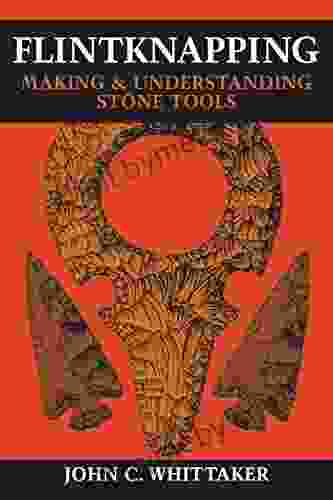Flintknapping, the ancient art of shaping stone into tools, has captivated humankind for millennia. From the earliest hand axes to the intricate spear points of the Stone Age, flintknapping played a pivotal role in human progress. Today, this fascinating craft continues to enthrall both enthusiasts and historians alike.
Flintknapping: A Glimpse into the Past
The history of flintknapping stretches back to the Lower Paleolithic era, around 2.6 million years ago. Our ancestors discovered that certain stones, such as flint and obsidian, could be struck with a hammerstone to create sharp, functional tools. These early tools were essential for hunting, scavenging, and shaping other objects, such as wooden spears and hide clothing.
4.7 out of 5
| Language | : | English |
| File size | : | 26313 KB |
| Text-to-Speech | : | Enabled |
| Screen Reader | : | Supported |
| Enhanced typesetting | : | Enabled |
| Word Wise | : | Enabled |
| Print length | : | 512 pages |
| Lending | : | Enabled |
As human technology evolved, so did flintknapping techniques. The development of specialized tools, such as antler and copper hammers, allowed for greater control and refinement in shaping stone. Different cultural groups throughout the world developed their own distinct styles of flintknapping, creating a rich tapestry of tool designs and traditions.
The Science of Flintknapping
Flintknapping is not simply a craft; it involves a deep understanding of the material properties of stone and the principles of fracture mechanics. The goal of flintknapping is to create a tool with specific characteristics, such as sharpness, durability, and balance. To achieve this, knappers must carefully select the right stone, prepare the core, and apply precise techniques to strike and shape the stone.
The process of flintknapping begins with selecting a suitable stone. Flint, a type of sedimentary rock, is the most common material used in traditional flintknapping, due to its conchoidal fracture properties. Conchoidal fracture is the tendency of stone to break into sharp, predictable shapes when struck with a hard object.
Once the stone is selected, the knapper prepares the core by removing any irregularities or imperfections. The core is then held in one hand while a hammerstone is used to struck the stone in precise locations. The angle of the blow and the force applied determine the size and shape of the flake that is removed.
Through a series of controlled strikes, the knapper gradually shapes the stone, removing flakes to create the desired tool form. The process requires patience, skill, and a deep understanding of the stone's behavior.
Modern Applications of Flintknapping
While flintknapping is often associated with ancient history, it is still practiced today for a variety of purposes. Archaeologists use flintknapping to recreate ancient tools and gain insights into past technologies. Craftspeople and artists use flintknapping to create beautiful and functional objects, such as jewelry, sculptures, and knives. Additionally, flintknapping is taught as a survival skill, providing knowledge of how to create tools from readily available materials.
"Flintknapping: Making & Understanding Stone Tools" - A Comprehensive Guide
For those fascinated by the art and science of flintknapping, "Flintknapping: Making & Understanding Stone Tools" by renowned flintknapper John Whittaker is an indispensable resource. This comprehensive book provides a detailed guide to all aspects of flintknapping, from selecting materials and preparing the core to shaping and refining tools.
Whittaker's book is written in a clear and engaging style, making it accessible to both novice and experienced flintknappers alike. It includes step-by-step instructions, detailed illustrations, and a wealth of historical and cultural information. Whether you are a hobbyist, a student of archaeology, or simply curious about this ancient craft, "Flintknapping: Making & Understanding Stone Tools" is an invaluable companion.
Flintknapping is a captivating craft that connects us to our human heritage. It is a testament to the ingenuity and adaptability of our ancestors, who harnessed the power of stone to create tools essential for survival. Today, flintknapping continues to fascinate and inspire, providing a glimpse into our technological past and a gateway to understanding the human experience.


























































































